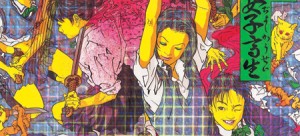Gal About Town
Review of Bye Bye Kitty!!!
Between Heaven and Hell in Contemporary Japanese Art
By Patricia Karetzky

Makoto Aida, Harakiri School Girls (detail) 2002
Japan Society
333 East 47th Street New York, NY 10017 Phone: 212.832.1155
Curated by David Elliott, founding Director of the Mori Art Museum,
Friday, March 18 — Sunday, June 12
The recent work of sixteen Japanese artists, half of whom are female, is on view at the Japan Society until mid June. The title of the show indicates that these artists have moved beyond the cute phenomenon exemplified by the cartoon character Hello Kitty. Indeed, many viewers were startled to find so many prophetic images of doom and destruction. Range widely in medium and format, the works are marvelously skillful and detailed. Here are short descriptions of but a few of the artists’ work. Miwa Yanagi in My Grandmother Geisha, photographs her wizened Nanny in full Geisha costume and makeup; this is a chilling image of old age and decay juxtaposed with traditional ideals of beauty. Yamaguchi Akira paints an extraordinary aerial view of Narita International Airport with several jets circling, waiting to land, as if he were a 16th century Japanese artist using such techniques as the bird’s eye view, arbitrary clouds that obscure details, and the roofless technique that allows views of interiors of the airplanes and the airport terminal. Using bright colors and miniscule detail, Yamaguchi renders the multitudinous activities found at the airport. Manabu Ikeda in Existence has drawn an incredibly old large tree that actually measures 67 inches tall. Seen among the gnarled bark of the trunk and leafy branches are tiny figures and flanking the iconic image are small-scale views of ancient decayed Buddhist cities of Sri Lanka and more, which are dwarfed by the size of the tree. Tomoko Shioyasu in breathing wall, blessing wall, creates a delicate and moving installation with her large-scale paper cuts: dramatically lit in the dark gallery, they are gently animated by the movements of passersby. Kohei Nawa, in PixCell Elk #24, is a taxidermy Elk, covered in crystal glass balls of various sizes. The image is unnerving as the balls, which give the impression of having been the agent of death, are still beautiful to behold. Motohiko Odani’s sculptures, SP Extra Malformed Noh Mask Series Half Skeleton’s Twins, eerily conjure up radiation poisoning, half of the classic Noh mask is covered by deformed growths.
Bye Bye Kitty!!! The sixteen featured artists are: Makoto Aida???; Manabu Ikeda???; Tomoko Kashiki????; Rinko Kawauchi????; Haruka Kojin????; Kumi Machida????; Yoshitomo Nara????; Kohei Nawa????; Motohiko Odani????; Hiraki Sawa?????; Chiharu Shiota????; Tomoko Shioyasu????; Hisashi Tenmyouya????; Yamaguchi Akira???; Miwa Yanagi?????; Tomoko Yoneda????.
Student Opportunities

The Emerging Landscape: Photographs and Drawings Exploring Real and Imaginary Landscapes
CURATORIAL INTERNSHIP
Society is an independent space showcasing contemporary art. Located in New York’s landmark Fuller Building, their exhibition program features innovative work by established artists with limited exposure in the United States and exhibition opportunities for emerging artists that inspire and integrate the local community. Society hosts free public and educational programs for the community promoting a greater understanding and appreciation of contemporary art and its practices.
The Curatorial Internship at Society is a rigorous and meaningful opportunity to work closely with the curatorial staff and current artists throughout the development of exhibitions, special projects, online initiatives, and educational events. Curatorial interns assist with upcoming programs and exhibition logistics including but not limited to: assisting with exhibition research, planning and installations, pubic program support, marketing, and correspondence with artists.
In exchange for their work interns will gain valuable experience in a dynamic arts environment. This is an unpaid internship. Exact days and hours will be discussed once selected to interview but ideal candidate should be able to start immediately and commit 20 hours/week. Hours and days are negotiable. Strong oral, written, organizational, and inter-personal communications skills are required. Ability to make independent decisions and manage time efficiently. Knowledge of contemporary art and art history, skilled in academic research, creating bibliographies, and writing proposals. Computer proficiency is a must, Microsoft Office; Adobe Illustrator. To apply p lease submit a resume and a cover letter stating interest, start date and availability per week to: Anna Di Stasi, Curator of Exhibitions, via email at: [email protected]
Gal About Town, Uncategorized
Along the Yangzi River:
Regional Culture of the Bronze Age from Hunan
China Institute in America
25 East 65th St, between Lexington and Park Avenues
Review by Patricia Karetzky
January 27, 2011 – June 12, 2011

Bronze Elephant
The China Institute is once again hosting a marvelous exhibition of the most precious objects lent from China. These ancient bronzes from the Hunan Provincial Museum are over three thousand years old. Beautiful and skillfully crafted, the bronze vessels, which represent a regional culture of the south, are a unique interpretation of local beliefs and decorative preferences. The rare elephant-shaped container, nearly 9 inches tall, is encrusted with a design comprising dozens of animals, making it especially fit for ritual use–it is a sort of gravy boat fashioned to hold liquids in its wide body with a lid and its trunk is the spout. A square bronze vessel nearly 16 inches tall has on each of its long sides, the image of a human face that menacingly looks out at the viewer. In addition there are dozens of finely crafted articles for the heating, mixing and drinking of wine as well as an assortment of tripods and large bowls for the preparation and serving of food. Several large size bells are also on view. In the darkly lit gallery, these ritual articles provide a real insight into the nature of sacred rituals in ancient China.


